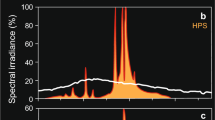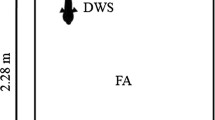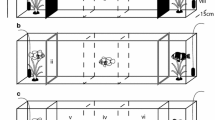Abstract
Two sand-dwelling cichlids from Lake Malawi (Aulonocara stuartgranti, Tramitichromis sp.) that feed on benthic invertebrates, but have different lateral line phenotypes, use lateral line and/or visual cues to detect prey under light versus dark conditions. The current study examined how ecologically relevant variation in light intensity [0–800 lux (lx)] influences detection of prey (mobile, immobile) in each species by analyzing six behavioral parameters. Both species fed at light intensities ≥1 lx and trends in behavior among light intensities were informative. However, prey type and/or time of day (but not light intensity) predicted all four parameters analyzed with generalized linear mixed models in A. stuartgranti, whereas the interaction of light intensity and time of day predicted three of these parameters in Tramitichromis sp. Data suggest that the critical light intensity is 1–12 lx for both species, that the integration of visual and lateral line input explains differences in detection of mobile and immobile prey and behavioral changes at the transition from 1 to 0 lx in A. stuartgranti, and that Tramitichromis sp. likely uses binocular vision to locate prey. Differences in the sensory biology of species that exploit similar prey will have important implications for the trophic ecology of African cichlid fishes.







Similar content being viewed by others
Abbreviations
- AICC:
-
Akaike information criterion
- GLMM:
-
Generalized linear mixed model
- Lx:
-
Lux
- PAR:
-
Photosynthetically active radiation
- SL:
-
Standard length
- TL:
-
Total length
References
Ali MA (1959) The ocular structure, retino motor and photo behavioral responses of juvenile pacific salmon. Can J Zool 37:965–996
Atema J (1971) Structures and functions of the sense of taste in the catfish (Ictalurus natalis). Brain Behav Evol 4:273–294
Batty RS, Blaxter JHS, Libby DA (1986) Herring (Clupea harengus) filter-feeding in the dark. Mar Biol 91:371–375
Bergstrom MA, Mensinger AF (2009) Interspecific resource competition between the invasive round goby and three native species: logperch, slimy sculpin, and spoonhead sculpin. Trans Am Fish Soc 138:1009–1017
Blanco-Vives B, Aliago-Guerrero M, Cañavate JP, García-Mateos G, Martín-Robles AJ, Herrera-Pérez P, Muñoz-Cueto JA, Sánches-Vázquez FJ (2011) Metamorphosis induces a light-dependent switch in Senegalese sole (Solea senegalensis) from diurnal to nocturnal behavior. J Biol Rhythms 27:135–144
Bootsma H, Jorgensen SE (2004) Lake Malawi/Nyasa: experience and lessons learned brief. In: companion CD-ROM for: ILEC (2005). Managing lakes and their basins for sustainable use: a report for lake basin managers and stakeholders. International Lake Environment Committee Foundation, Kusatsu, Japan, pp 259–276
Collin SP (1989) Topographic organization of the ganglion cell layer and intraocular vascularization in the retinae of two reef teleosts. Vision Res 29:765–775
Collin SP, Shand J (2003) Retinal sampling and the visual field in fishes. In: Collin SP, Marshall NJ (eds) Sensory processing in aquatic environments. Springer, New York, pp 139–169
Confer JL, Howick GL, Corzette MH, Kramer SL, Fitzgibbon S, Landesberg R (1978) Visual predation by planktivores. Oikos 31:27–37
Coombs S (1999) Signal detection theory, lateral-line excitation patterns and prey capture behaviour of mottled sculpin. Anim Behav 58:421–430
Dalton BE, Cronin TW, Marshall NJ, Carleton KL (2010) The fish eye view: are cichlids conspicuous? J Exp Biol 213:2243–2255
Denton EJ, Gray JAB (1988) Mechanical factors in the excitation of the lateral lines of fish. In: Atema J, Fay RR, Popper AN, Tavolga WN (eds) Sensory biology of aquatic animals. Springer, New York, pp 595–617
Denton EJ, Gray JAB (1989) Some observations on the forces acting on neuromasts in fish lateral line canals. In: Coombs S, Gorner P, Münz H (eds) The mechanosensory lateral line: neurobiology and evolution. Springer, New York, pp 229–246
Diehl S (1988) Foraging efficiency of three freshwater fishes: effects of structural complexity and light. Oikos 53:207–214
Dunbrack RL, Dill LM (1984) Three-dimensional prey reaction field of the juvenile coho salmon (Oncorhynchus kisutch). Can J Fish Aquat Sci 41:1176–1182
Durham SR, Dietl GP, Visaggi CC (2012) The mismeasure of behavior: a natural history revision of prey preference in the banded tulip snail. J Shellfish Res 31:101–109
Fryer G (1959) The trophic interrelationships and ecology of some littoral communities of Lake Nyasa with especial reference to the fishes, and a discussion of the evolution of a group of rock-frequenting Cichlidae. Proc Zool Soc Lond 132:153–281
Fryer G, Iles TD (1972) The cichlid fishes of the great lakes of Africa: their biology and evolution. Oliver and Boyd, Edinburgh
Gardiner JM, Motta PJ (2012) Largemouth bass (Micropterus salmoides) switch feeding modalities in response to sensory deprivation. Zoology 115:78–83
Grant SM, Dieckhoff HW, Mayland HJ, Meyer MK (1987) Ecology of Aulonocara REGAN, 1922 in Lake Malawi. Cour Forsch Inst Senckenberg 94:131–139
Guildford SJ, Bootsma HA, Fee EJ, Hecky RE, Patterson G (2000) Phytoplankton nutrient status and mean water column light intensity in Lakes Malawi and superior. Aquat Ecosyst Health 3:35–45
Guildford SJ, Bootsma HA, Taylor WD, Hecky RE (2007) High variability of phytoplankton photosynthesis in response to environmental forcing in oligotrophic Lake Malawi/Nyasa. J Great Lakes Res 33:170–185
Harden Jones FR (1956) The behaviour of minnows in relation to light intensity. J Exp Biol 33:271–281
Henderson MA, Northcote TG (1985) Visual prey detection and foraging in sympatric cutthroat trout (Salmo clarki clarki) and dolly varden (Salvelinus malma). Can J Fish Aquat Sci 42:785–790
Hofmann CM, O’Quin KE, Marhsall NJ, Cronin TW, Seehausen O, Carleton KL (2009) The eyes have it: regulatory and structural changes both underlie cichlid visual pigment diversity. PLoS Biol 7(12):e1000266
Holbrook SJ, Schmitt RJ (1984) Experimental analyses of patch selection by foraging black surfperch (Embiotoca jacksoni Aggasiz). J Exp Mar Biol Ecol 79:39–64
Howick GL, O’Brien WJ (1983) Piscivorous feeding behavior of largemouth bass: experimental analysis. Can J Fish Aquat Sci 42:785–790
Janssen J (1997) Comparison of response distance to prey via the lateral line in the ruffe and yellow perch. J Fish Biol 51:921–930
Jordan R, Kellogg K, Howe D, Juanes F, Stauffer J, Loew E (2006) Photopigment spectral absorbance of Lake Malawi cichlids. J Fish Biol 68:1291–1299
Kirk JTO (2011) Light and photosynthesis in aquatic ecosystems, 3rd edn. Cambridge University Press, New York
Konings A (1990) Koningʼs book of cichlids and other fishes of Lake Malawi. TFH Publications Inc., Neptune City
Konings A (2007) Malawi cichlids in their natural habitat, 4th edn. Cichlid Press, El Paso
Laur DR, Ebeling AW (1983) Predator-prey relationships in surfperches. Env Biol Fish 8:217–229
Lythgoe JN (1979) The ecology of vision. Clarendon Press, Oxford
Mazur MM, Beauchamp DA (2003) A comparison of visual prey detection among species of piscivorous salmonids: effects of light and low turbidities. Environ Biol Fish 67:397–405
McComb DM, Kajiura SM (2008) Visual fields of four batoid fishes: a comparative study. J Exp Biol 211:482–490
McWilliam RA, Minchinton TE, Ayre DJ (2013) Despite prolonged association in closed populations, an intertidal predator does not prefer abundant local prey to novel prey. Biol J Linn Soc 108:812–820
Miyazaki T, Iwami T, Meyer-Rochow VB (2011) The position of the retinal area centralis changes with age in Champsocephalus gunnari (Channichthyidae), a predatory fish from coastal Antarctic waters. Polar Biol 34:1117–1123
Moller P (2002) Multimodal sensory integration in weakly electric fish: a behavioral account. J Physiol Paris 96:547–556
Montgomery JC, Coombs S (1992) Physiological characterization of lateral line function in the Antarctic fish Trematomus bernacchii. Brain Behav Evol 40:209–216
Montgomery JC, Diebel C, Halstead MBD, Downer J (1999) Olfactory search tracks in the Antarctic fish Trematomus bernacchii. Polar Bio 21:151–154
Montgomery JC, McDonald F, Baker CF, Carton AG, Ling N (2003) Sensory integration in the hydrodynamic world of rainbow trout. Roy Soc Lond B Bio 270(2):S195–S197
Montgomery JC, Windsor S, Bassett D (2009) Behavior and physiology of mechanoreception: separating signal and noise. Integr Zool 4:3–12
Montgomery JC, Bleckmann H, Coombs S (2014) Sensory ecology and neuroethology of the lateral line. In: Coombs S, Bleckmann H, Fay RR, Popper AN (eds) The lateral line system. Springer, New York, pp 121–150
Parry JWL, Carleton KL, Spady T, Carboo A, Hunt DM, Bowmaker JK (2005) Mix and match color vision: tuning spectral sensitivity by differential opsin gene expression in Lake Malawi cichlids. Curr Biol 15:1734–1739
Partridge BL, Pitcher TJ (1980) The sensory basis of fish schools: relative roles of lateral line and vision. J Comp Physiol 135:315–325
Parzefall J (1993) Behavioural ecology of cave-dwelling fishes. In: Pitcher T (ed) Behaviour of teleost fishes, 2nd edn. Chapman & Hall, London, pp 573–608
Patterson G, Hecky RE, Fee EJ (2000) Effect of hydrological cycles on planktonic primary productivity in Lake Malawi/Niassa. Adv Ecol Res 31:421–430
Richmond HE, Hrabik TR, Mensinger AF (2004) Light intensity, prey detection and foraging mechanisms of age 0 year yellow perch. J Fish Biol 65:195–205
Rickel A, Genin A (2005) Twilight transitions in coral reef fish: the input of light-induced changes in foraging behaviour. Anim Behav 70:133–144
Ryer CH, Olla BL (1999) Light-induced changes in the prey consumption and behavior of two juvenile planktivorous fish. Mar Ecol Prog Ser 181:41–51
Sabbah S, Gray SM, Boss ES, Fraser JM, Zatha R, Hawryshyn CW (2011) The underwater photic environment of Cape Maclear, Lake Malawi: comparison between rock- and sand-bottom habitats and implications for cichlid fish vision. J Exp Biol 214:487–500
Schmidt D, O’Brien WJ (1982) Planktivorous feeding ecology of arctic grayling (Thymallus arcticus). Can J Fish Aquat Sci 39:475–482
Schmitt R, Holbrook SJ (1984) Ontogeny of prey selection by black surfperch Embiotoca jacksoni (Pisces: Embiotocidae): the roles of fish morphology, foraging behavior, and patch selection. Mar Ecol Prog Ser 63:6–12
Schmitz L, Wainwright PC (2011) Nocturnality constrains morphological and functional diversity in the eyes of reef fishes. BMC Evol Biol 11:338
Schwalbe MAB, Webb JF (2014) Sensory basis for detection of benthic prey in two Lake Malawi cichlids. Zoology 117:112–121
Schwalbe MAB, Bassett DK, Webb JF (2012) Feeding in the dark: lateral-line-mediated prey detection in the peacock cichlid Aulonocara stuartgranti. J Exp Biol 215:2060–2071
Sivak JG (1978) The functional significance of the aphakic space of the fish eye. Can J Zool 56:513–516
Taplin RH (2007) Experimental design and analysis to investigate predator preferences for prey. J Exper Mar Biol Ecol 344:116–122
Townsend CR, Risebrow AJ (1982) The influence of light level on the functional response of a zoo planktonivorous fish. Oecologia 53:293–295
Vinyard GL, O’Brien WJ (1976) Effects of light and turbidity on reaction distance of bluegill (Lepomis macrochirus). J Fish Res Board Can 33:2845–2849
Vogel JL, Beauchamp DA (1999) Effects of light, prey size, and turbidity on reaction distances of lake trout (Salvelinus namaycush) to salmonid prey. Can J Fish Aquat Sci 56:1293–1297
Warrant EJ (2004) Vision in the dimmest habitats on Earth. J Comp Physiol A 190:765–789
Webb JF (2014) Morphological diversity, development, and evolution of the mechanosensory lateral line system. In: Coombs S, Bleckmann H, Fay RR, Popper AN (eds) The lateral line system. Springer, New York, pp 17–72
Webb JF, Montgomery JC, Mogdans J (2008) Bioacoustics and the lateral line system of fishes. In: Webb JF, Fay RR, Popper AN (eds) Fish bioacoustics. Springer, New York, pp 145–182
Acknowledgments
We thank Drs. Karen Carleton (University of Maryland) for her expertise in cichlid vision, Stephanie Guildford (University of Minnesota Duluth) for her expertise on light levels in Lake Malawi, and Graham Forrester (University of Rhode Island) and Rebeca Rosengaus (Northeastern University) for statistical expertise. We also thank Edward Baker (Facilities Manager, RI NSF EPSCoR Marine Life Science Facility), Emily Becker, Brandon Fuller, Christopher Holland, Callie Veelenturf, Rebecca Scott, and Benjamin Sevey for assistance with fish husbandry, Dr. Christopher Kenaley (Harvard University) for doing the µCT scans, and Benjamin Sevey for generating the 3D images in Fig. 1. This work was carried out under an approved University of Rhode Island IACUC protocol (#AN08-11-005). This research was assisted by funds provided by NSF EPSCoR Cooperative Agreement EPS-0554548 and EPS-100405, the College of the Environment and Life Sciences (University of Rhode Island) and was supported by NSF grant IOS 0843307 to JFW.
Author information
Authors and Affiliations
Corresponding author
Rights and permissions
About this article
Cite this article
Schwalbe, M.A.B., Webb, J.F. The effect of light intensity on prey detection behavior in two Lake Malawi cichlids, Aulonocara stuartgranti and Tramitichromis sp.. J Comp Physiol A 201, 341–356 (2015). https://doi.org/10.1007/s00359-015-0982-y
Received:
Revised:
Accepted:
Published:
Issue Date:
DOI: https://doi.org/10.1007/s00359-015-0982-y




